If you’re reading this, you probably belong to a generation that writes their business plans on a napkin over a friendly coffee chat and implements them overnight.
Oops! Another fail? In between the pivoting and desperate quest for the novel, sit quietly and ponder. It’s already there. Just look closely and you’ll see the emerging patterns in the turbulent world of business.
The term ‘business model’ has multiple interpretations ranging from sheer monetization strategy to an entire business architecture. The attitudes vary, too. Some entrepreneurs don’t give a hoot, while others scrupulously design and constantly de-risk a business model canvas (BMC), the model’s visual representation.
So why does it matter?
The authors of Business Model Generation explain, ‘a business model describes the rationale of how an organization creates, delivers, and captures value’. They not only suggest a simple visual way of breaking down the initial idea into a 9-component canvas but also capture the 5 patterns of today’s online company dynamics.
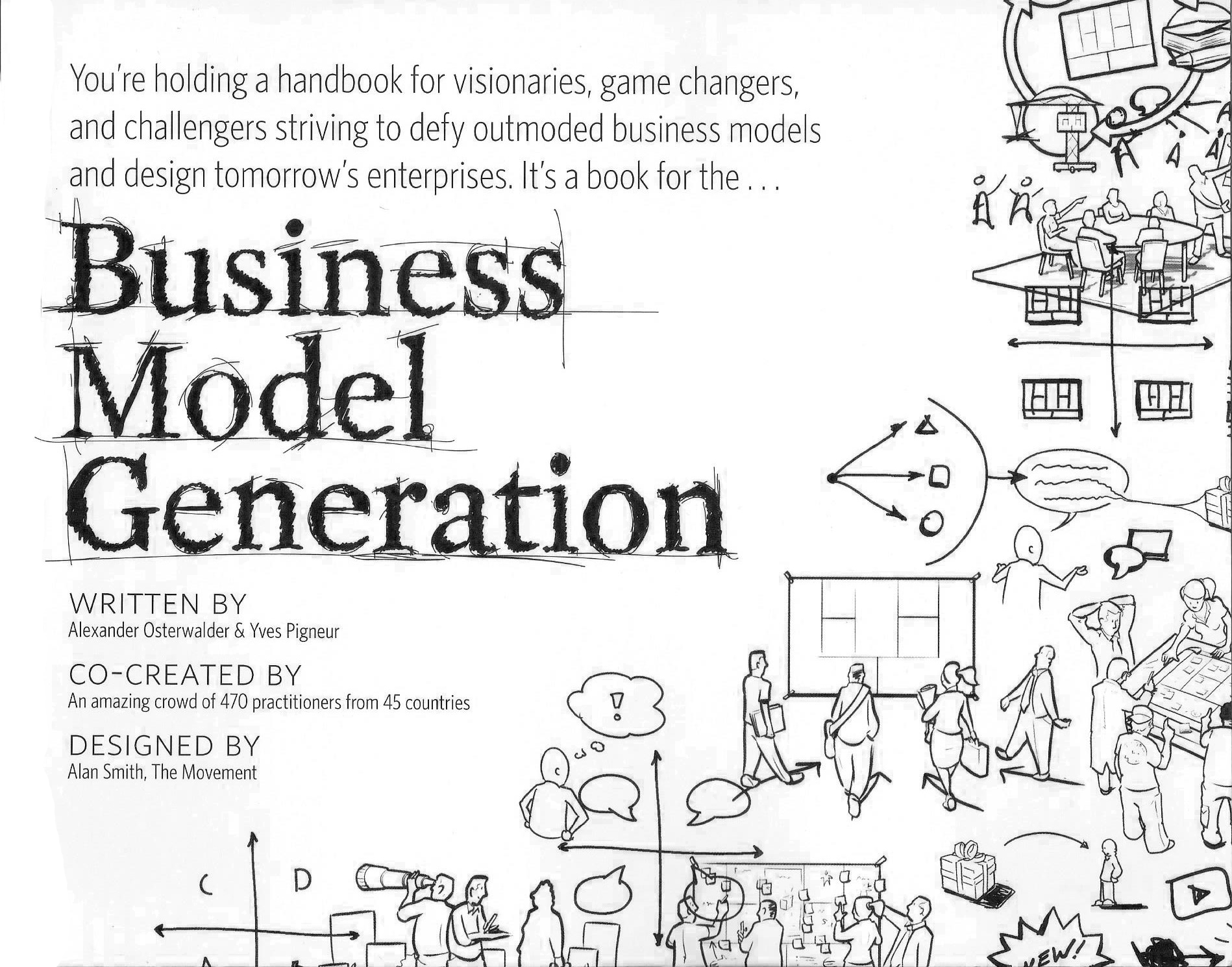
Let’s discover these five patterns – their logic, merits or pitfalls, successful companies, and how to make them work for you.
Pattern #1. Unbundling
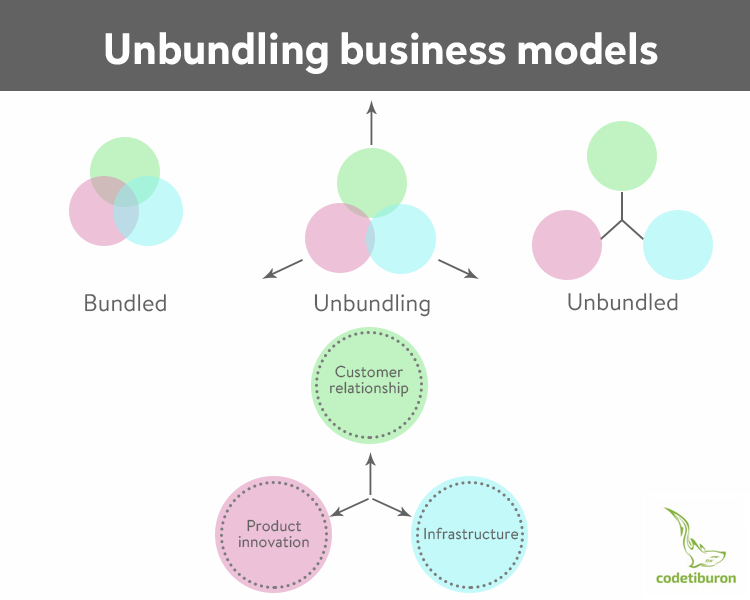
Not so long ago, large generalist companies ruled the market. Recently, their strengths – size, reputation, integration – lost luster and gave way to the creativity, speed, and flexibility of small specialist businesses.
Context
Before |
After |
|---|---|
| An integrated model combines infrastructure management, product innovation, and customer relationship under one roof. | The business is unbundled into three separate but complementary models:
|
Separating unrelated activities
The model shows the dynamics of some businesses that have proven more viable than large monolithic vertical corporations of the past. Over a time, a company ‘unbundles’ into three fundamentally different business areas. Those three may coexist in one organization, but they better be different entities, to avoid conflicts and undesirable trade-offs.
The three entities naturally play different roles.
- Customer relationship identifies, attracts, and builds relationships with customers.
- Product innovation conceives new products and services and monetizes them.
- Infrastructure management focuses on building and managing facilities for high-volume, repetitive operational tasks.
How to make Unbundling work
Each business comes with their own economic, competitive, and cultural prerequisites of success.
Economically, customer acquisition is costly, so gaining a large share of wallet is necessary; economies of scope are key to this model. Companies compete for scope, rapidly consolidate, and eventually, a handful of big players dominate the market. They are highly service-oriented and adopt a customer-comes-first mentality.
For product innovation, early market entry allows for premium price and a large market share, so speed is crucial. They compete for talent, which means low entry barriers and many small players thrive as a result. The corporate culture is employee-centered, the creative stars are coddled.
In infrastructure management, high fixed costs make large volumes a necessity to achieve low unit costs, so economies of scale are key. It entails battle for scale and rapid consolidation so that a few big players dominate. They adopt a cost-focused culture with stressed standardization, predictability, and efficiency.
Unbundling on a BMC
Let’s break down the specifics of the three unbundled areas and highlight the major focus of each.
Success with Unbundling
Poster children are Apple and Dell. Large corporations stay laser-focused on customer relationship while outsourcing other activities to niche contractors.
Mobile communications: unbundling equipment/network/content. Telco outsourced content and equipment, to sharpen its focus on branding and segmenting customers and services.
Private Banking: unbundling platforms/products/relationships. A Swiss private bank, Maerki Baumann, decided to focus solely on customer relationship and counsel.
Similar processes occur in news publishing, pharmaceutics, IT.
Pattern #2. Long Tail
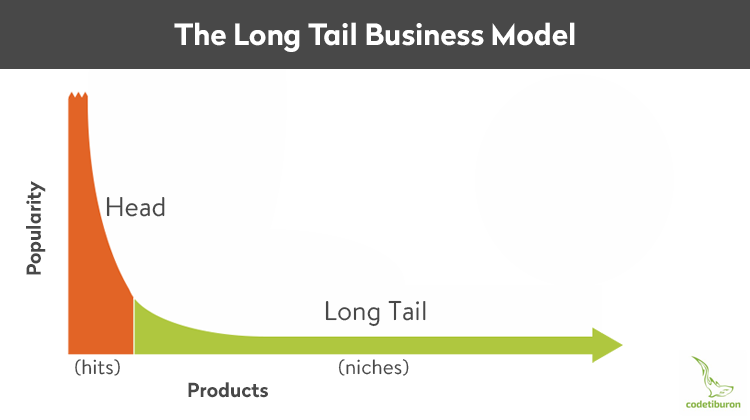
Context
Before |
After |
|---|---|
| The value proposition targets only the most profitable customers | The new or additional value proposition targets both popular and niche product consumers |
Culture unfiltered by economic scarcity
Products in low demand or with low sales volume can collectively make up a market share that rivals or exceeds the relatively few current bestsellers and blockbusters but only if the store or distribution channel is large enough
.
Online distribution and retail has brought about a new mentality of sales, media and entertainment economics – from hit-driven sales of limited items to non-discriminatory sales of both ‘hits’ and ‘misses’.
The Long Tail business model brings in focus an assortment of niche products that sell relatively infrequently. They add value in an online environment:
- Aggregate sales of niche items can be as profitable as bestsellers due to low inventory cost of online retail.
- Strong platforms make niche content readily available to interested buyers.
- Virtual space is ideal since it’s limitless, accessible and friendly towards various tastes.
The concept was dubbed ‘long tail’ by Chris Anderson in 2004. He believes 3 triggers gave rise to this phenomenon in the media industry:
- Democratisation of tools and production
- Democratisation of distribution
- Falling search costs to connect supply with demand
Merits of Long Tail
- Increased revenue: since both hits and misses are equal in terms of revenue, the money can add up quickly to a huge new market.
- A better way of marketing: it makes up for our poor understanding of the market demands – when consumers are offered infinite choice, the true shape of demand is revealed.
- Non-discriminatory: popularity no longer has a monopoly on profitability.
- Infinite shelf-space effect: no shelf space to pay for in online sales.
- Low-cost: no manufacturing costs; hardly any distribution fees.
Tradition Vs Innovation
Traditional ‘hit’ mindset |
Innovative ‘long-tail’ mindset |
|---|---|
| Believes in the 20-80 rule: only 20% of goods become hits. | There’s a demand for virtually 99% of goods. |
| Only a narrower range of popular goods are worth selling. | Both ‘hits’ and ‘misses’ generate revenue. |
| Offline retail has constraints – scarce shelf space, high manufacturing costs, distribution fees. | No such constraints in online retail – the products are permanently available. |
| ‘One-size-fits-all’ approach to marketing and sales. | Highly personalized market. Embraces diversity of supply and demand. |
How to make Long Tail work
Simply offering more variety does not shift demand by itself. Both supply and demand sides are active contributors. The demand for niche products is shaped by special tools or techniques called ‘filters’. These are of two kinds – software and people.
Software (recommendations)
- Algorithm-fuelled recommendations: the algo-detected patterns in buyers’ shopping habits creating a positive feedback loop:
- Buzz: Google PageRank, del.icio.us;
- Ratings (active): Netflix recommendations, eBay ratings;
- Behavior (passive): Amazon recommendations, Audioscrobbler, Yahoo Music custom radio stations;
- AI: Semantic analysis, audio analysis.
People (tastemakers, influencers)
- Pros (editors): Critics, celebrities, Rhapsody category editors, librarians, SavageBeast (Pandora) musicologists;
- Amateurs (mavens): Blogs, playlists, customer reviews, Wikipedia contributors, smart friends;
- Mobs (distributed intelligence): taggers, linkers, file-traders.
Long Tail on a BMC

Success with Long Tail
- Online sales: the success of Ebay is based in a large army of auctioneers selling and buying small quantities if non-hit items. Amazon gets half its sales from outside its 130,000 top titles.
- Media and entertainment industry: a shift towards licensing a large number of niche movies (Netflix).
- Niche tourism: an assortment of niche products and services are marketed and sold online and the demand side provides the wealth of information that is available to tourism consumers via social media tools (blogs, discussion groups, and podcasts). Among the trending tourism long-tails are sustainability, experience-economy, self-development & individuality, hedonism, consumerism, conscious living.
- Fashion: check our case study on Styberry – a fashionista publishing platform for tailored content about fashion, beauty, and lifestyle.
The model has a great potential for many areas.
Pattern #3. Multi-sided platform
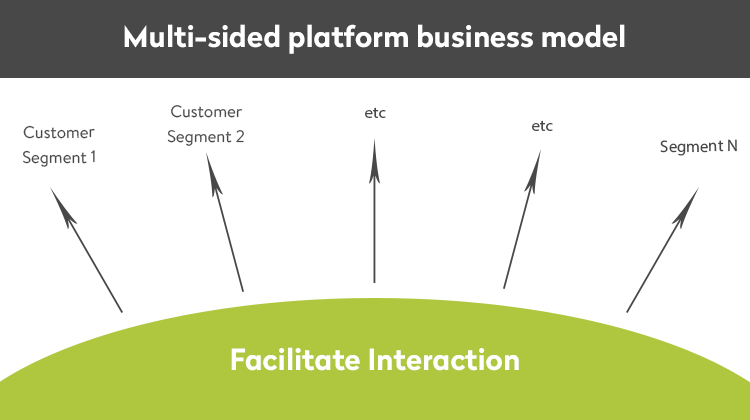
Context
Before |
After |
|---|---|
| One value proposition targets one customer segment | A value proposition gives access to a company’s customer segments, to create a revenue stream (e.g., Google to paid advertisers) |
It takes two…
This model, a.k.a. P2P / sharing economy / online marketplace / multi-sided market model, has this rationale:
- Two or more homogeneous groups interact and bring together supply and demand.
- An intermediary operates the platform to facilitate interactions and adds revenue streams later.
Challenges of Multi-sided platforms
Multi-sided platforms are notoriously difficult to start for several reasons.
- The chicken-egg problem: buyers don’t come because the platform is dubious and lacks inventory, sellers aren’t interested because there’s no one to sell to.
- The double-company problem: you’re building two businesses simultaneously, and it’s either both work or they don’t.
Take Airbnb. They had to attract people willing to rent or lease lodgings. The market was new and so building awareness was crucial. They had to take care of SEO, design & photography, site development. It took the platform over two years to grow to 10,000 users and 2,500 listings. Want to know how they did it?
How to make Multi-sided platforms work
- Forget automation – do everything manually. Once the platform takes off, automation is crucial. But it doesn’t mean you need to start automating right off. Setting up your business manually will give you valuable experience that you would miss otherwise.
- Create happy buyers before the network effect. Start generating value even while you’re small. Threadless matches people seeking unique T-shirts with people who create them. Even if the site contained only ten T-shirts, as long as they were awesome, buyers would still be able to buy a cool T-shirt. Scarcity is a thing that makes a T-shirt ‘cool’.
- Serve the seller side first. After all, they’re already in business and so are easier to find. Create an irresistible offer, like 12 months’ free or low-price lock-in. Sellers are alsways motivated to have more eyeballs and sales.
- Be innovative in attracting buyers. SEO, traditional marketing, AdWords cost a fortune. Since everybody else has long been doing the same, how can you stand out or even catch up? Do it your way. Jeff Bezos, for one, devised a winning marketing strategy for Amazon – a Virtuous Cycle.
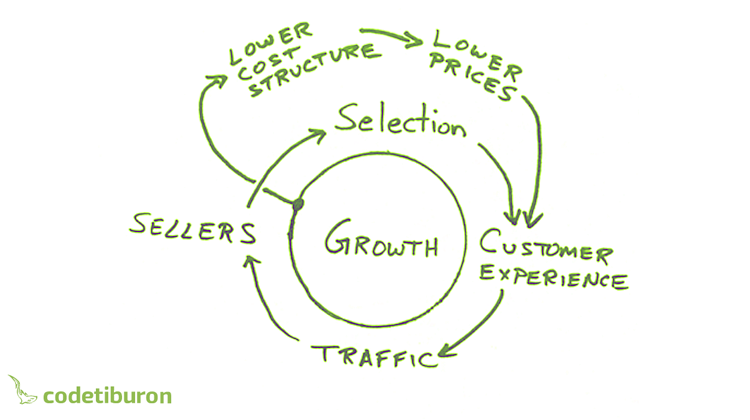
Multi-sided platforms on a BMC
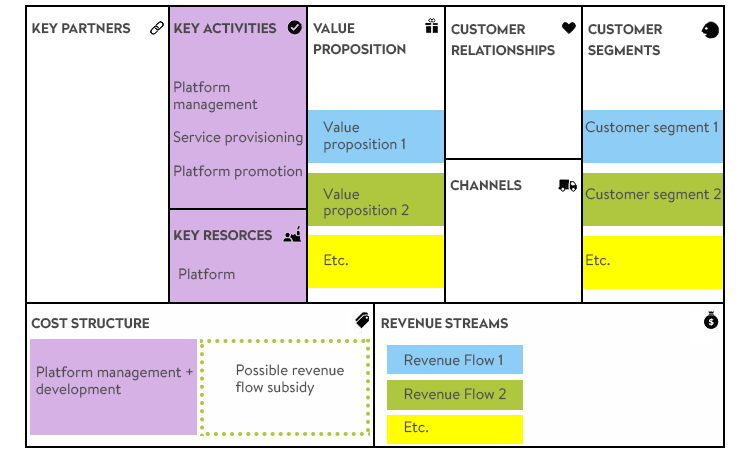
Success with Multi-sided platforms
- Advertisement and marketing platforms: Google’s VP is providing extremely targeted text advertising globally over the Web. Of the three customer groups – searchers, content owners, and advertisers – only the last one is paid.
- RE sales & rentals: Airbnb has built a platform to bring together homeowners and travelers looking for short-term rentals. Both groups are paying users.
- Social networking sites (SNS): Facebook is on a world’s mission to power connectivity by providing a free platform for customer segments with various VPs. Among the other freebies, it provides tools and APIs for developers. The key paying segment is advertisers.
- Professional networking sites: LinkedIn is a platform to leverage the power of connectivity between job seekers and recruiters, marketers/advertisers and business. It offers free basic tools as well as paid solutions for all these categories of users.
Pattern #4. FREE

Context
Before |
After |
|---|---|
| A high-value, high-cost value proposition is offered to paying customers only | Several VPs are offered to different customer segments with different revenue streams. One of them is free or very low-cost |
The power of FREE
In this model:
- at least one of the customer segments continuously uses the product/service free of charge
- different patterns make the subsidized offer possible
- non-paying customers are financed by another customer segment
Merits of FREE
- It’s irresistible. That’s the most powerful VP. I mean, who doesn’t like freebies?!
- Best marketing tactic. Given that sales and marketing eat up a lion’s share of business funds, freebies are a great lead-generating tool (the free model invests heavily into the engineering of a great product, which at the same time becomes its marketing strategy – much leaner than the traditional marketing). Thus product development overlaps with customer development.
- Ensures market leadership. A large base of free users creates market value in making the product attractive to investors as potentially monetizable (think WhatsApp). Having a large market share (albeit not paying) positions you as a market leader, which is self-reinforcing in the tech industry. The financial markets and acquirers realize that market leadership is worth a significant premium over niche players that may have more revenue.
Challenges of FREE
- Psychologically, it’s hard to get a user to pay for what once was free.
- Working out an effective monetization strategy is tricky. A general mistake is to calculate the costs based on these:
- similar products’ costs;
- ‘expert’ opinion;
- ‘we worked hard so we’ll charge $X’ idea.
- Making the most valuable features ‘paid’ is risky if not fatal. You may lose a considerable number of users if your basic free product becomes less attractive.
There are several ways to get it right.
How to make the FREE model pay off
There’s one prerequisite for success: the free product has to be of high value to result in high customer satisfaction and cause a networking effect.
Old FREE
Complimentary products. ‘Razor-&-Blade’ (after King C. Gillette), aka ‘bait-&-hook’ – the basic product is cheap, or even free. The consumables that are needed to use or operate it, on the other hand, are expensive and sold at high margins.
The model has a variety of implementations:
- give away the cell phone, sell the monthly plan;
- make the game console cheap and sell expensive games;
- sell inkjet printers cheap and profit on ink cartridges;
- install fancy coffeemakers in offices at no charge so you can sell managers expensive coffee sachets.
Today, it’s widely adopted as FREEMIUM. We’ll get to that shortly.
New FREE
Scale. The Web is a freaky land of FREE. The cost of equipment is high, and the marginal costs of technology nears… zero. The solution? Scale. The Web is all about scale, finding ways to attract the most users for centralized resources, spreading those costs over larger and larger audiences as the technology gets more and more capable.
Create a habit. Many internet products come unnoticed. To truly appreciate a product, users need to ‘experience’ and ‘get used to’ it (forgive the repetition!). A free or low-cost initial period of a valuable product forms a habit. After that the price is raised. (think Dropbox). Locking-in with customers in long-term contracts also works here.
FREE, but not completely so
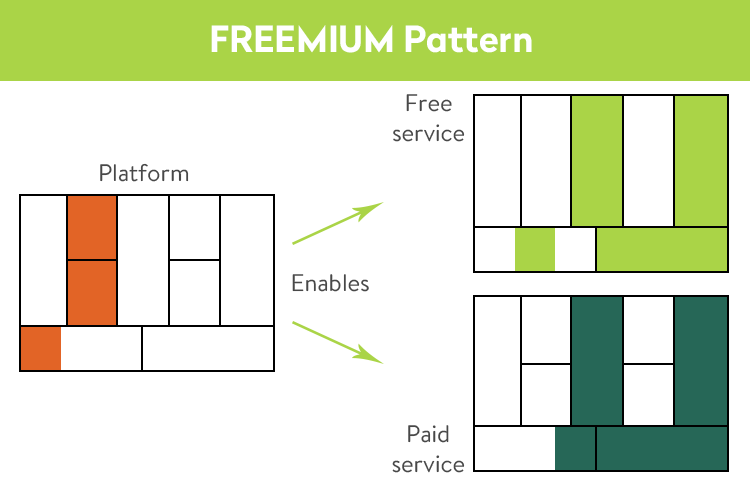
Since FREE is not free for all and not necessarily free for good, there are different shades of FREE called FREEMIUM. In the FREEMIUM model key metrics to watch are the average cost of serving a free user and the rates at which free users convert to premium customers.
- FREEMIUM: get the basics for free, pay for more. A classical model where a handful of premium users subsidize a large base of free users is only viable is the marginal costs are low. A product may start as free and then switch to freemium. Think Tinder. The basic dating app was upgraded to Tinder Plus, granting its premium users with additional highly desirable features, an ad-free experience, and better search results.
- Open-source: FREEMIUM with a twist. No more high costs to support teams of software experts and no more per-user licenses or product upgrades. But a product no one ‘owns’ can be risky. Since the open source community does a fair share of non-paid work, a little bit of testing, stabilization, and maintenance may be way cheaper. Think Red Hat. The company provides subscription-based 7-year long support and maintenance of open-source software, Linux in particular. It guarantees freeware quality and viability at a lower price than traditional software releases. Software value depends on the community of experts and users, timely upgrades, documentation, certification, and stable work. Open-source does a great job here.
- The insurance model (FREEMIUM upside down). A large base of customers pay small regular fees to protect themselves from unlikely – but financially devastating events. In short, this large paying base subsidizes a small group of people with actual claims (think Rega, the crowdsurance platform utilizing blockchain technology).
FREE on a BMC
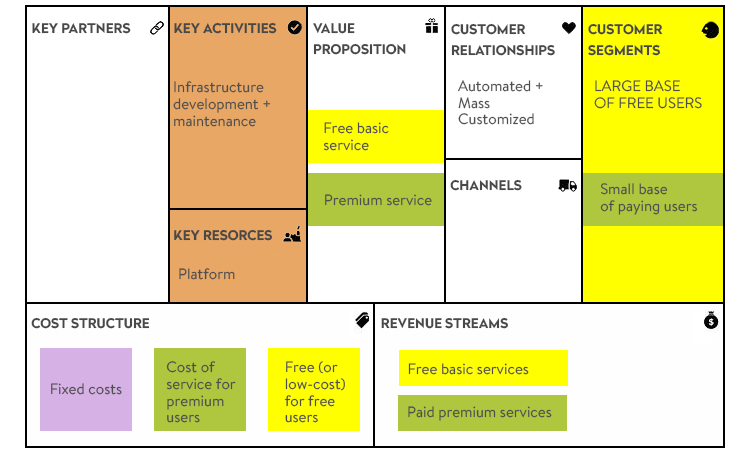
Success with FREE
You can see how it works in companies like Google, Facebook, MySQL, HubSpot, Skype, WhatsApp and many more.
- Google, the leader in search engine usage, provides its valuable technology free, while advertisers (using AdWords and AdSense) are paid customers.
- MySQL uses dual-licensing, which is like the freemium in reverse – you pay for the basic product, but use premium for free under certain conditions. Users can choose an open source GPL or a commercial license.
- Dropbox – provides a free initial experience of using the product before users can appreciate its true value. Then the price is raised.
- Skype and WhatsApp – telephony and SMS disruptors – still provide their streamlined products for free. The paying users are enterprise and business clients.
- HubSpot offers a free website grader to provide paid advice and website customization for the leads.
Pattern #5. Open
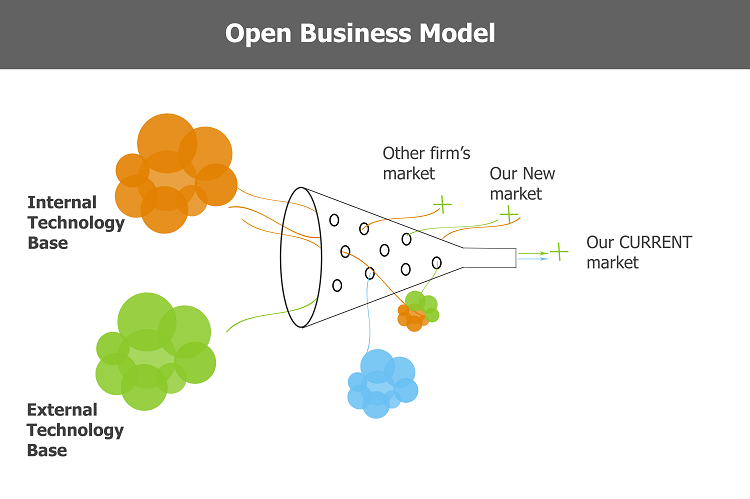
Context
Before: Closed Innovation |
After: Open Innovation |
|---|---|
|
|
Inside-out / outside-in
In a world characterized by distributed knowledge, organizations can create more value and better exploit their own research by integrating outside knowledge, intellectual property, and products into their innovation processes
What’s the logic behind the open business model? An organisation is no longer a citadel, nor a chamber of secrets.
Since R&D is costly or slow, acquiring R&D from external sources can be less expensive or faster-to-market. On the other hand, sharing the unused internal intellectual property creates new revenue streams.
This philosophy results in the two vectors:
- Inside-out: innovation occurs when organizations license or sell their intellectual property or technologies, particularly unused assets.
- Outside-in: innovation occurs when an organization brings external ideas, technology, or intellectual property into its development and commercialization.
How to monetize the Inside-out Open model
Several types of the Creative Commons license make it possible to benefit from opening IP to public use. For example, the authors of the Business Model Generation handbook, A.Osterwalder and Y.Pigneur, licensed the business model canvas with a CC BY-SA Creative Commons license. That allows us to share and adapt the idea while giving credit to its creators.
But how to generate revenue with the inside-out open model? Let’s look at some methods:
- Digital-to-physical. The CC-licensed goods are available to access/innovate/participate in online for free. When converted into physical, costs are incurred. For example, OpenDesk offers digital furniture designs to download and customize for free; they also connect clients with local manufacturers who use smart milling tools to materialize the designs. That activity creates a revenue stream.
- Direct connect. Eliminates the middleman between creatives and the market. The licensed work is put up online for everyone to listen, read, use, and distribute it. The revenue streams? Donations, pay-what-you-can, free & for sale, crowdfunding, unlatching, patrons.
- Matchmaking. Tech platforms act as a middleman creating an online presence of creatives and a one-stop shop for consumers (e.g., Tribe of Noise provides its community of music creators with a Free and Pro plans under different licenses).
- Value-add services. Services are built on top of a resource that is free and open. The revenue comes from the added value – customization, hosted and supported access, supplemental resources, training and education (e.g., Lumen Learning provides low-cost courseware as an alternative to expensive commercial courses. It adds value by curating free online materials and designing curriculums).
Open on a BMC
Success with Open
Outside-in: Procter&Gamble scanned outside, attracting university IP, external and retired scientists to solve internal problems.
Inside-out: GlaxoSmithKline’s patent pools had this rationale: unused internal ideas, R&D, intellectual property related to diseases in poor nations create value when ‘pooled’. The company’s VP was to make drugs more accessible to the poor and facilitate the research of understudied diseases. Genzyme licenses technology from the outside and then develops it in-house. The company has turned external ideas into an array of novel therapies that deliver important cures for previously untreatable rare diseases.
One final thought
So does that mean you need to stick with the five archetypal patterns? What about the innovation part? The point is that if you get into practice of noticing the patterns, dynamics, and factors that work for others, you’ll be more certain of what will work for you.
Have an innovative idea of an online business? Give us a call and let’s discuss!

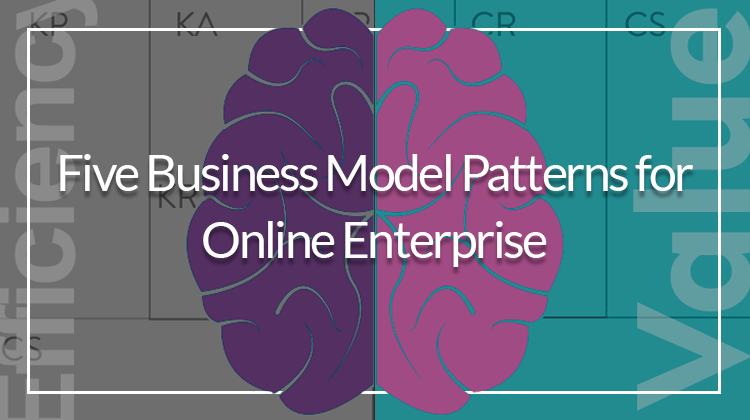

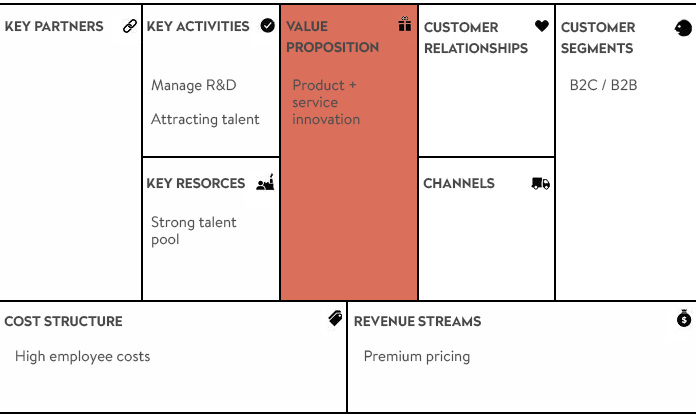

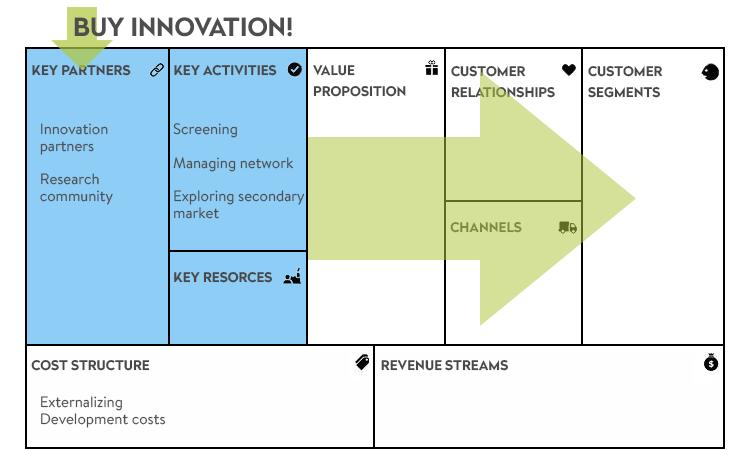
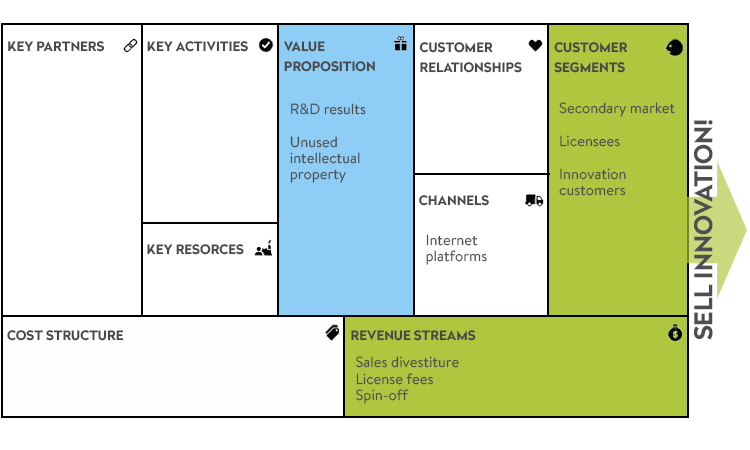
Worth able, Thanks for sharing this content. Keep sharing.